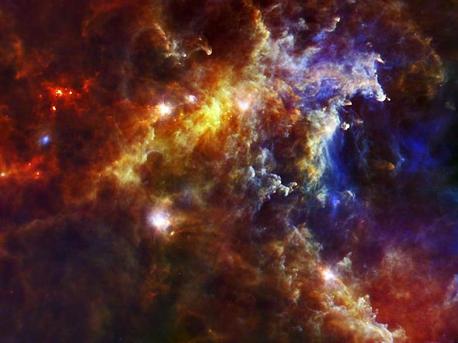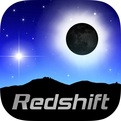Stellar evolution
Herschel Reveals Ripening Stars Near Rosette Nebula
 © ESA and the PACS, SPIRE & HSC consortia |
This image from the Herschel Space Observatory shows most the cloud associated with the Rosette nebula, a stellar nursery about 5,000 light-years from Earth in the Monoceros, or Unicorn, constellation. Herschel collects the infrared light given out by dust. The bright smudges are dusty cocoons containing massive embryonic stars, which will grow up to 10 times the mass of our sun. The small spots near the center of the image are lower mass stellar embryos. The Rosette nebula itself, and its massive cluster of stars, is located to the right of the picture.
The image shows most of the cloud associated with the Rosette nebula, located about 5,000 light-years from Earth in the constellation Monoceros, the Unicorn. The region contains a family of growing stars, with the oldest and most massive members in the center of the nebula, and younger and less massive generations located farther out in the associated cloud. The nebula's cluster of the most massive stars, located beyond the right edge of the picture, is responsible for hollowing out the cavity. There's enough dust and gas in the entire Rosette cloud to make about 10,000 suns.
The large, embryonic stars uncovered by Herschel are thought to be a younger generation. They are located inside the tips of pillars that appear to branch out from thicker cloud material. The pillars were, in fact, excavated by the nebula's massive star cluster. Winds and radiation from those stars pushed less dense material away from the pillars, and probably triggered the birth of the big stars inside the finger-like structures. In fact, the pillars point to the location of the massive nebula stars.
The intermediate-mass stellar embryos, each a couple of times as massive as the sun, are located in the redder regions of the image. The small spots near the center of the image are lower-mass embryonic stars, similar in mass to the sun.
Astronomers study regions like the Rosette not only to learn how stars form in our Milky Way, but also to get a better idea of what's going on in distant galaxies. When astronomers look at faraway galaxies, they are seeing light from regions that are bursting with massive stars. In order to compare our galaxy to distant ones, it is therefore important to understand high-mass star formation.
Herschel collects the infrared light from dust. The infrared light is color-coded as follows: light with a wavelength of 70 microns is blue; 160-micron light is green; and 250-micron light is red. The observations were made with Herschel's Photoconductor Array Camera and Spectrometer and the Spectral and Photometric Imaging Receiver instruments.
source: NASA
Stellar evolution
Herschel Reveals Ripening Stars Near Rosette Nebula
 © ESA and the PACS, SPIRE & HSC consortia |
This image from the Herschel Space Observatory shows most the cloud associated with the Rosette nebula, a stellar nursery about 5,000 light-years from Earth in the Monoceros, or Unicorn, constellation. Herschel collects the infrared light given out by dust. The bright smudges are dusty cocoons containing massive embryonic stars, which will grow up to 10 times the mass of our sun. The small spots near the center of the image are lower mass stellar embryos. The Rosette nebula itself, and its massive cluster of stars, is located to the right of the picture.
The image shows most of the cloud associated with the Rosette nebula, located about 5,000 light-years from Earth in the constellation Monoceros, the Unicorn. The region contains a family of growing stars, with the oldest and most massive members in the center of the nebula, and younger and less massive generations located farther out in the associated cloud. The nebula's cluster of the most massive stars, located beyond the right edge of the picture, is responsible for hollowing out the cavity. There's enough dust and gas in the entire Rosette cloud to make about 10,000 suns.
The large, embryonic stars uncovered by Herschel are thought to be a younger generation. They are located inside the tips of pillars that appear to branch out from thicker cloud material. The pillars were, in fact, excavated by the nebula's massive star cluster. Winds and radiation from those stars pushed less dense material away from the pillars, and probably triggered the birth of the big stars inside the finger-like structures. In fact, the pillars point to the location of the massive nebula stars.
The intermediate-mass stellar embryos, each a couple of times as massive as the sun, are located in the redder regions of the image. The small spots near the center of the image are lower-mass embryonic stars, similar in mass to the sun.
Astronomers study regions like the Rosette not only to learn how stars form in our Milky Way, but also to get a better idea of what's going on in distant galaxies. When astronomers look at faraway galaxies, they are seeing light from regions that are bursting with massive stars. In order to compare our galaxy to distant ones, it is therefore important to understand high-mass star formation.
Herschel collects the infrared light from dust. The infrared light is color-coded as follows: light with a wavelength of 70 microns is blue; 160-micron light is green; and 250-micron light is red. The observations were made with Herschel's Photoconductor Array Camera and Spectrometer and the Spectral and Photometric Imaging Receiver instruments.
source: NASA





